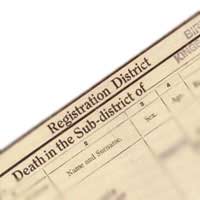Death Certificates 1837 to Present Time: Family History Research

They say only two things in life are certain: death and taxes, and there are records of both. But to a genealogist, death is actually the least important part of the cycle. Once a person's been born and had children, their genealogical use is, to all intents and purposes, over. After all, you can trace your ancestors without knowing when they died, and a lot of family trees don't include the date of death.
But death certificates definitely have their place in genealogy. The age at death can give a very close idea of birth date, and the home address can be used to locate the family on the census.
Death Certificates: What to Look For to Help Trace Family History
As with birth and marriage certificates, deaths have been recorded by the state since 1837. However, if all you need to know is the age of a person at death, for much of the period you don't need to find a copy of the full certificate. Between 1866 and1969, the age at death was listed in the national index (a zero means under the age of one). After that, date of birth is shown instead.The death certificate shows where and when the deceased died, name and surname, sex, age (or d.o.b.), occupation (or last occupation if retired) and address, and cause of death, along with the signature, description and address of the person giving information about the death, along with when it was registered and the name of the registrar.
One thing to be taken with a pinch of salt is the cause of death. All too often it's a euphemism for something else, and as you go back to Victorian times, diagnoses become notoriously inaccurate. Since 1874 a doctor's certificate has been a necessity for the issuance of a death certificate, and often accompanies it. Indeed, until that date, it wasn't even necessary to put a cause of death on the certificate! That said, between 1858 and 1874, a certificate should state whether the death had been certified or not by a doctor.
You might notice a reference to a certified period of time in the cause of death column. This might refer to the statutory maximum period between death and burial. In the case of an epidemic like cholera, for example, it would be 24 hours. These figures can prove to be of interest.
There are actually rules covering informants of death. If an inquest has been held, then the coroner should be the informant. Otherwise it should be a relative of the deceased present at the death, a relative there during the final illness, a relative in the district, anyone present at the death, the occupier if they knew of the death, anyone else on the premises, and finally the person disposing of the body. Deaths must normally be registered within five days.
Records of Stillbirths Could Help Your Family History Research
Stillbirths are a category unto themselves, and create an entry that's both birth and death certificate. The compulsory registration of stillbirths only began in 1927, with the cause of death only added after 1960. Prior to 1874 you didn't need a certificate to bury a stillborn child. A stillbirth has to be registered within three weeks of the event. Before 1983 the baby couldn't be name, and still can't be named in retrospect.Records of Deaths Abroad: Outside England or Wales
If a British citizen dies abroad, the death should be recorded in the same manner as a birth or marriage - that is by the consul or high Commissioner, as has been the case since 1849. However, if the body is returned home for burial, the registrar in Britain has to issue a "certificate of no liability" (curiously, nothing is necessary if the person is cremated abroad and the ashes brought home). You can find these records at the National Archives.- The Holocaust and Family Records
- What Gravestones Can Tell Us
- New Zealand Death Records
- Cremation Records and Tracing Your Family History
- Genealogy and Pre-1538 Death Records
- Genealogy Information From The Cemetery
- How To Proceed In Genealogy Without A Death Certificate
- Using Probate Registries to Find Death Records for Genealogy


Re: Using Criminal Records For Family History Research
Hi all i wanted to find out about my dad's past and nobody seems to know much about it or what he did.…
Re: Maiden Names in Genealogy
Looking for my fathers mother maiden name
Re: Genealogy and a Criminal Past
I am trying to find out about my father crime in 1992 or 1993 my father as pass away 1998 and I would like to find out why he got…
Re: Using Criminal Records For Family History Research
I am trying to find my biological father's police criminal record as I was abused as a child but have…
Re: Cremation Records and Tracing Your Family History
I am trying to find out where has my friends aunt Adelinda Diaz McMullen was cremated and who was her…
Re: Cremation Records and Tracing Your Family History
CAN SOMEONE PLEASE HELP ME WITH TRYING TO FIND OUT WHERE MY FATHER WAS CREMATED/BURIED IN KENT UK. I…
Re: What If You Have Asian Roots?
Ancestor Edward Albert Wells was born in Trichinopoly on 8 May 1833 to his father George Wells of the 54th Regiment at Foot and…
Re: How to Use Church Marriage Records to Trace Your Ancestors
It is still legal for first cousins to marry.
Re: Cremation Records and Tracing Your Family History
My sister finance was cremation and she stayed up by his bedside at Augusta university for days on out…
Re: Cremation Records and Tracing Your Family History
I am trying to find out where my partners mother was cremated. Patricia Florence Bennett. Cremated…